Every application’s value depends on access to accurate data that resides close to the application, while being compliant with mandated data residency requirements. An application deployed across multiple clouds needs access to data in the form of tables, graph, documents, and images consistently wherever it resides. While application development frameworks and pipelines are consolidating, data stores are diversifying. The industry is grappling with special-purpose databases for every data type whose deployment collectively can overwhelm the data administrators. What we need is an enterprise-class database that handles all data types and can be deployed across all the major cloud service providers.
By 2025, enterprises can implement such a database model by using the Oracle Autonomous Database across the four hyperscalers: Oracle Cloud Infrastructure (OCI), Amazon Web Services (AWS), Google Cloud Platform (GCP), and Microsoft Azure.
What governs data
As data management grows in importance with the rise of enterprise AI, regulatory bodies worldwide are responding with more stringent requirements, including the following examples:
- Financial services: The Digital Operational Resilience Act (DORA) Act refers to information and communication technology (ICT) risk and sets rules on ICT risk-management, incident reporting, operational resilience testing, and ICT third-party risk monitoring. This regulation acknowledges that ICT incidents and a lack of operational resilience can jeopardize the soundness of the entire financial system, even if there’s adequate capital for the traditional risk categories.
- National defense: The Department of Defense (DoD) exerts tremendous effort planning and using traditional strategic assets, such as personnel, weapon systems, supply chain, and transportation to achieve positive outcomes. In the same manner, data in the DoD is a high-interest commodity and must be used in a way that brings both immediate and lasting military advantage
- International law enforcement: The US Clarifying Lawful Overseas Use of Data (CLOUD) Act is designed with various structural elements that collectively aim to strike a balance between privacy interests and law enforcement needs. The Act empowers US law enforcement to access data stored overseas through US data providers. The CLOUD Act is designed to permit foreign partners that have robust protections for privacy and civil liberties to enter into bilateral agreements with the United States to obtain direct access to this electronic evidence, wherever it’s located, to fight crime and terrorism.
These regulations call for minimal data replication across multiple locations, consistent management of data regardless of type, such as structured, unstructured, graph, geospatial, and vectors, and managing the database, keeping it secure, and ensuring consistency of the store data across geographies.
The following approaches meet these goals:
- Create a plethora of specialized databases, each tailored to a specific data type and a geo-location.
- Standardize on a converged database with a single operating posture across data types and geographies.
Oracle offers a converged database that manages all data types and can reside across private data centers and all the hyperscalers.
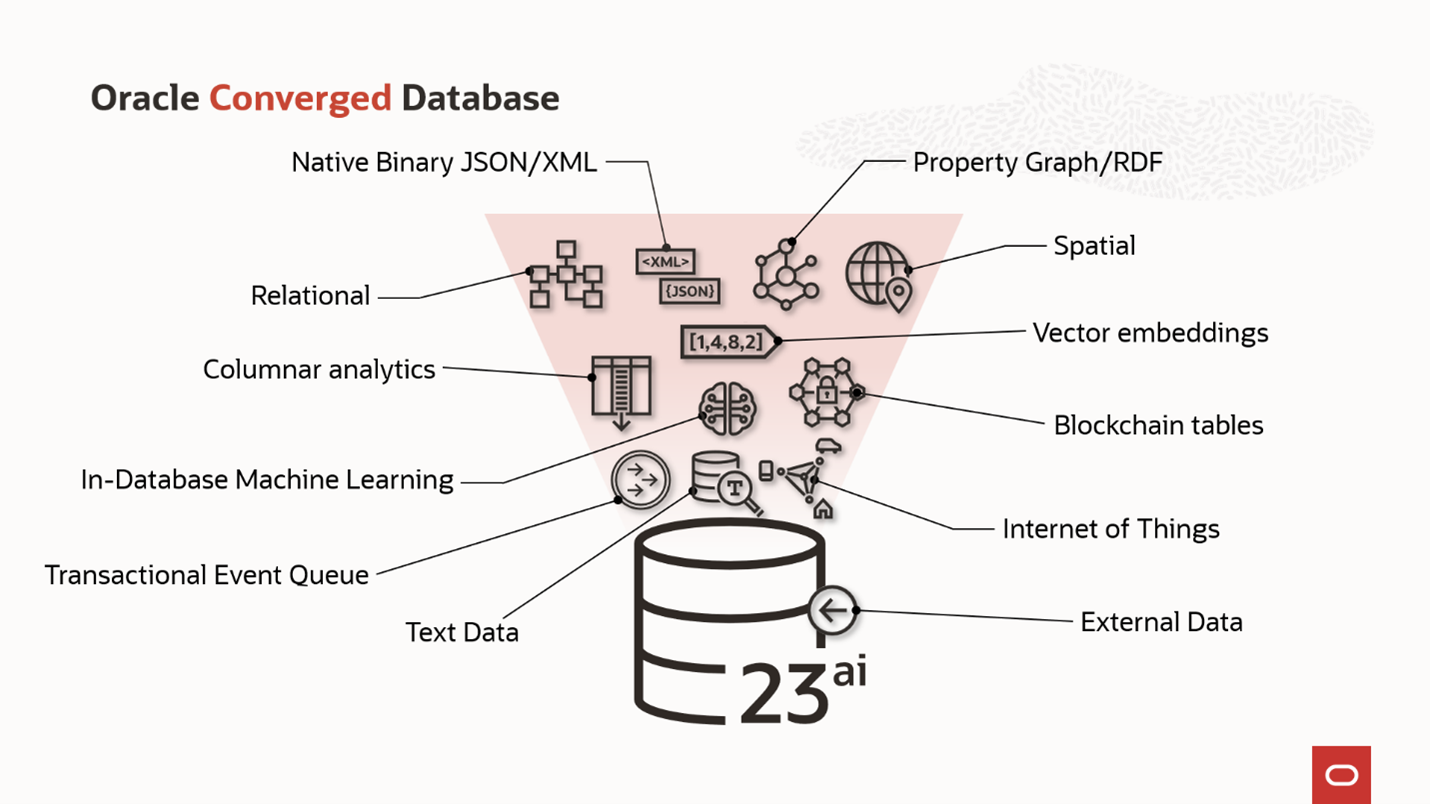
Composition of Oracle Converged Database
“Oracle is once again demonstrating why its converged approach to database architecture is superior to specialized databases in driving enterprise acceleration,” says Holger Mueller, vice president and principal analyst at Constellation Research. “Take the data sovereignty use case. Customers typically have three or more specialized databases, such as OLTP, analytics, AI, and documents, which means that each one has a different architecture with different APIs, different capabilities, and unique limitations. Each database and data flows between databases must be manually configured, tested and maintained over release changes to meet data sovereignty requirements. “
A converged database must be geographically collocated with the applications and users for performance and to meet regulatory requirements for data residency. Working with the hyperscalers over many years, Oracle has delivered on this need, with Autonomous Database becoming co-resident with the major application hosting cloud environments.
Autonomous Database across multiple clouds
As the following figure shows, the trends toward cloud adoption, multicloud for service selection, and risk reduction are accelerating:
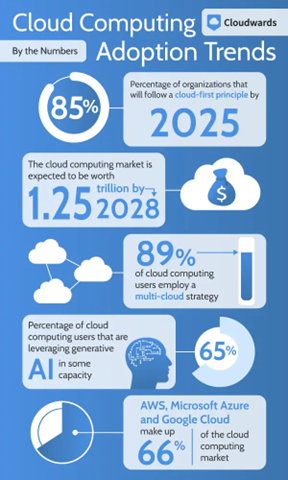
Cloud computing adoption trends according to Cloudwards
Data in OCI
Hosting your data in Autonomous Database offers the following features and capabilities:
- Deploy your apps in the cloud or your data center with OCI’s distributed cloud offerings.
- Start small while allowing your apps to scale as needed with a database used by the most demanding applications, without rearchitecting your app or overspending on compute resources.
- Stay focused on app development using a database that helps you ensure uptime and safeguard data through automated security measures and continuous monitoring.
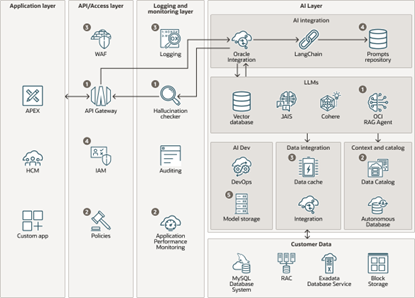
Example architecture diagram for a deployment of an enterprise-level Generative AI stack in OCI.
Data across AWS and OCI
Generate deeper analytical insights by combining the performance, availability, scale, and security of Oracle Database services with zero-extract transform load (ETL) integrations with AWS Analytics. This combination can enable you to run near-real-time analytics and machine learning on your data without having to build and manage complex data pipelines. With near real-time machine learning with Amazon SageMaker, you can also use your data with Amazon Bedrock and Amazon Q for generative AI use cases.
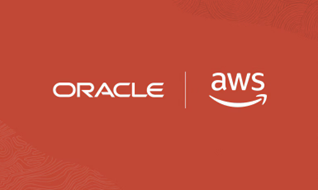
Oracle and AWS strategic partnership
Data across Azure and OCI
With Oracle Database@Azure in Azure data centers, developers can easily provision an industry-leading data platform that can accommodate any data or development model for any use case, while eliminating or reducing the complex and time-consuming integrations. Customers can run or build cloud applications that combine Oracle Database services with native Microsoft Azure services and benefit from extremely low latency and high performance.
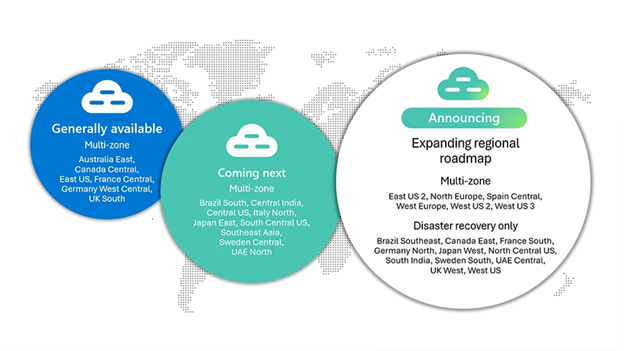
Available and announced mutlizone regions for Oracle Database@Azure.
Data across GCP and OCI
Oracle Database@Google Cloud brings Oracle technologies into Google Cloud, such as Oracle Exadata Database Service, Oracle Autonomous Database, Oracle Real Application Clusters (RAC), Oracle Database Autonomous Recovery Service, and Oracle Data Guard. The solution integrates into Google Cloud networking and Google Cloud Virtual Private Cloud (VPC) access.
“With Oracle Database@Google Cloud, customers can combine data from Oracle databases with Google Cloud services like Gemini foundation models and the Vertex AI development platform to develop and run a new generation of cloud native applications,” says Carl Olofson, research vice president of Data Management Software at IDC.
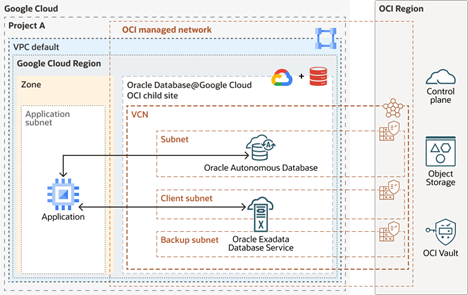
Architecture diagram for a deployment of Oracle Database@Google Cloud.
Conclusion
Customers of every business want assurance that, when they seek information or services from enterprises, they can base their decisions on data that’s relevant, readily available, and secure. This assurance comes from the database. A secure, highly performant database available globally forms the foundation for AI-driven applications.
“Now that Oracle Database supports even more data types and development paradigms, developers have more opportunities to solve a wide range of problems with one unified, powerful approach,” said Richard Winter, CEO and principal architect at WinterCorp. “Oracle Database 23c Free—Developer Release offers a jumpstart on applying new technologies that simplify the creation of modern data-driven apps. For example, developers need no longer use specialized databases for document and relational data. JSON Relational Duality in Oracle Database 23c unifies both so that data is held once, but can be accessed, written, and modified with either approach. This capability is unique to Oracle. It delivers “App Simple” from Oracle.”
When Oracle’s converged database is hosted on OCI and all hyperscalers, enterprise application developers and data architects can come together to confidently build data and AI powered applications at global scale.
Start your data as platform journey by signing up for Oracle Cloud Infrastructure Free Tier.
For more information, see the following resources:
- OCI: A complete cloud infrastructure platform for every workload
- Oracle Cloud Architecture Center
- Oracle Database@Azure
- Oracle Database@Google Cloud
- Oracle Database@AWS
- Oracle Database 23ai